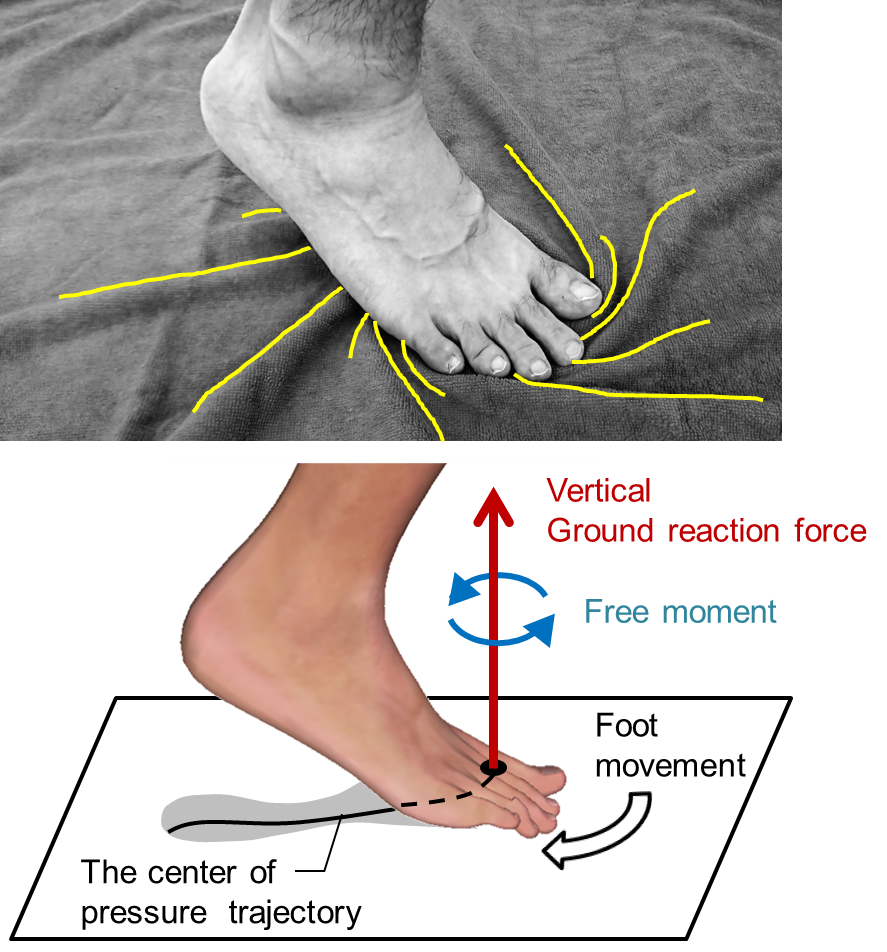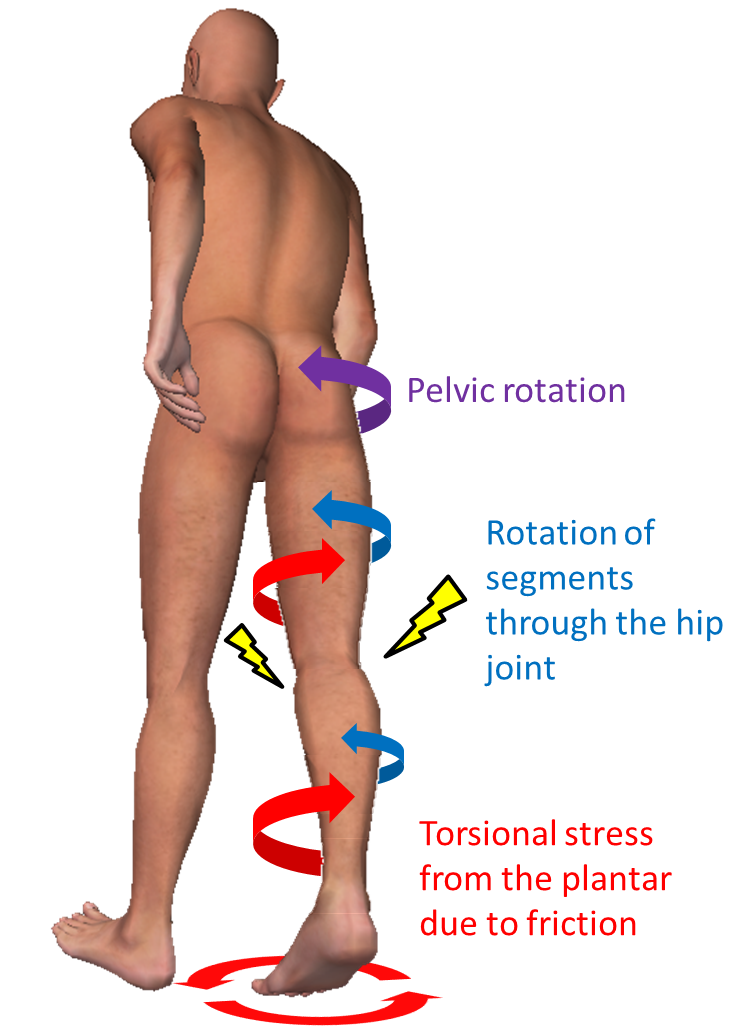Elucidation of the characteristic of walking in which the torsional stress occurring in the lower limb increases
October 19, 2017
POINT
- It is the first time in the world to clarify that the torsional stress occurring in the lower extremity during walking correlates with the relative torsional angle between the foot and the pelvis.
- Focusing on the parameter of free moment and analyzing walking, it was suggested that the torsional stress occurring in the lower limbs is controlled by the flexibility of the hip joint when the kick off the ground.
- It can be expected to be applied for rehabilitation and prevention of motor disorders such as osteoarthritis of the knee.
Okawa T. (Bunkyo Univercity) of the Cell to Body & Mind Dynamics Laboratory team member (Material Health Science Donation Course, Organic Material Science, Tokyo University of Agriculture and Technology(TAT)) revealed worldwide for the first time that the torsional stress occurring in the lower extremity during walking correlates with the relative torsional angle between the foot and the pelvis with Atomi T. (Teikyo University of Science), Hasegawa K. (JAXA), and Atomi Y. (Tokyo University of Agriculture and Technology).
Research group leader Yoriko Atomi, a visiting professor of TAT, have laid emphasis for such research and education as solving and binding mechanism of both levels that controls the human body motion acquired by upright bipedal posture and locomotion and cell shapes and motility produced by three types of cytoskeleton dynamics commonly seen in multicellular organism. The key is “dynamic instability”, which governs both cells consisted of multicellular organism and animal body, especially in upright human system. These systems are consisted of soft and finely tuned materials, resulting in producing diversity of life system because of their instable characteristics. Following the cellular mechanism published in last year (Plos One 2016)*, we believe this time will be the first step in elucidating the mechanism for human beings.
When we are walking straight, we do not realize that twisting will occur in the body. Human body has a multisegment structure composed of many joints, and it can be seen that when walking, body movement and plantar friction cause convolution in each body segment such as foot (heel to toe) and pelvis. It is also noticeable at the daily level that twisting will occur even if you wear shoes that do not fit your feet and between the sole and the shoe. On the other hand, because the soles of the feet are fixed by friction with the floor, rotational stress will occur on the whole lower extremity. In addition, it is known that the rotational stress occurring in the lower extremity is related to various motor diseases such as gonarthrosis which is often found in females and older adults. However, it has not been clarified how the torsional stress occurring in the lower extremity is related to gait characteristics. The result of this study suggests that the free moment, which is an index of the torsional stress occurring at the plantar surface, is related to the flexibility of the hip joint, which has a large degree of freedom as the structure of the joint compared with other joints in our body.
In other words, it turned out that the lower the flexibility of the hip joint, the more the torsional stress tends to increase in the lower extremity. Although it seems unlikely that the sole of foot and hip is far from distance, if the flexibility of hip joints and problems in use, the twisting force applied to the sole affects the knee joint and the possibility of causing deformation we imagine. This research result shows the necessity of not only considering the human body as a unit of each segment but also as a whole, leading to elucidation of the health problem of super aged society, in particular the disease prevention mechanism which becomes a clue to solving the Locomotive Syndrome Is expected.
*Shimizu M, Tanaka M, Atomi Y (2016) Small Heat Shock Protein αB-Crystallin Controls Shape and Adhesion of Glioma and Myoblast Cells in the Absence of Stress. PLoS ONE 11(12): e0168136. https://doi.org/10.1371/journal.pone.0168136
http://www.tuat.ac.jp/documents/tuat/outline/disclosure/pressrelease/2016/20161228_01.pdf
Prior to being published in Gait and Posture journal, the results of this research were posted on the web on September 10th.URL: http://www.gaitposture.com/article/S0966-6362(17)30898-6/abstract
Research background
:Even while walking straight, body segments, such as the pelvis, femur and tibia, rotate in three dimensions. The foot has a tendency to rotate outward when the kick off the ground (Figure 1). Meanwhile, although the propulsive force is obtained by using the friction generated between the floor surface and the plantar, in that case, the opposite direction force is applied to stop the rotation of the foot. Friction is an indispensable factor for walking, but excessive friction will be a "bad" stress for human being consisted of cells responding to mechanical stimuli. Each joint consists of cells and extracellular matrix secreted by cells. Bones consisting of mainly collagen, a major extracellular matrix, are known to be mechanically vulnerable to torsional stress. Our research team focused on the free moment (FM), which is a force generated by friction which has not received much attention as an indicator of torsional stress. FM is defined as the strength of the rotating force centered on the pressure applied to the foot(Figure 1). In recently, it has been reported that if the FM becomes large, it is related to the tibial stress fracture of the distance runner and the torsional deformation of the tibia. However, the characteristic of walking with large or small FM has remained unclear until now. Therefore, in order to clarify the gait characteristics with large torsional stress occurring in the lower extremity, we conducted research using a three-dimensional motion analysis device.
Research organization
:In this research, Yoriko Atomi (visiting professor, emeritus professor of University of Tokyo), Takahiro Okawa (Bunkyo Gakuin University), Tomoaki Atomi (Teikyo University of Science), Katsuya Hasegawa (JAXA), among members of the Cell to Body & Mind Dynamics Laboratory team at Tokyo University of Agriculture and Technology graduate school of engineering, conducted.
Results
:During walking, every step, the pelvis is constantly rotated, the legs are fixed to the floor by friction. Therefore, based on the hypothesis that the relative rotation angle between the foot and the pelvis affect the magnitude of FM, the walking parameters such as the direction of the foot and the angle of rotation of the pelvis during walking were examined correlation with magnitude of FM. Among the analyzed gait parameters, only the relative torsional angle between the foot and the pelvis affected the magnitude of FM, and it turned out that FM increases as the amount of torsion is small. The relative angle between the foot and the pelvis occurs when the foot supports the body, and it is done mainly by the hip internal rotation. In other words, it was revealed that the torsional stress generated in the lower extremity became large if the internal rotation did not occur in the hip joint during the center of gravity shifted to the opposite foot (Figure 2). In addition, we investigated not only the supporting legs, but also the influence of the opposite legs, however there was no tendency to affect FM. Based on the above research results, it was found that the person with small internal rotation of the hip joint during kicking off the ground during walking has a high rotational stress on the lower extremity. In addition, when considering the stress on the body during walking, not only focusing on one joint or segment, it is suggested that the importance of capturing the exercise throughout the body and evaluating it.
Prospects
:In this study, we found that FM as an indicator of torsional stress strongly reflects the gait characteristics. It has been pointed out that the torsional stress occurring in the lower extremity is related to diseases such as osteoarthritis of the knee and anterior cruciate ligament injury. It has also been revealed that the tibia and femur of children with cerebral palsy are more torsioned than the bones of healthy children. Future research will elucidate the characteristics of walking peculiar to the disease and can be expected to help prevent motor disorders that helps extend the healthy life span in a super aging society and to help rehabilitation for the disease. It will be the healthy strategy for the people who live in a super aged society that dynamically links and draws both abilities of the cell and the movement including walking. In other words, the health strategy is to elucidate the coordination mechanism of shape, tension, and center of gravity control and disseminate it to education.


◆Inquiries about this research◆
Tokyo University of Agriculture and Technology Graduate School of Engineering Research Organic Materials Chemistry and Materials Health Sciences Donation Course
Visiting Professor: Yoriko Atomi
Tel/Fax +81-42-388-7539
E-mail yatomi(insert @ symbol here)cc.tuat.ac.jp
Related Information
Elucidation of the characteristic of walking in which the torsional stress occurring in the lower limb increases(PDF:702KB)
TUAT research factors (English): http://www.rd.tuat.ac.jp/en/activities/factors/index.html
Press release (Japanese): 下肢に生じる捻じれストレスが高まってしまう歩き方を解明(PDF:481KB)
